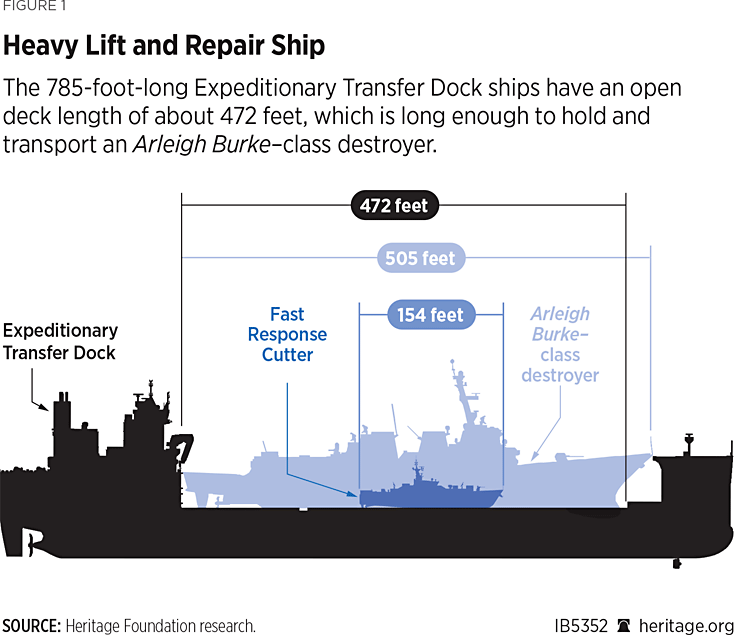The U.S. Navy faces the possibility of a Pacific war with China that it is unprepared to sustain, with too few options for conducting forward battle damage repairs, at a time when the Navy has too little capacity to replace lost warships. At the same time, the nation is under assault by narcotics cartels, and the Navy and the U.S. Coast Guard (USCG) seem unable to staunch the flow. Fortunately, there exists a potential solution to both problems in the Navy’s inactive fleet.
Proposal
Specifically, the Navy should return to service and repurpose two Expeditionary Transfer Dock ships (ESDs), both of which have a decade of life left. USNS Montford Point (ESD-1) should be used at once as a mothership in support of maritime counter-narcotic operations in the Southern Command theater and optionally to support USCG and Navy Central Pacific operations. USNS John Glenn (ESD-2) should be used as a heavy lift repair ship to develop various expeditionary warship battle repair techniques that would be critical in a major Pacific war.
Rationale
Both ESD-1 and ESD-2 are currently in an inactive reduced operating status, which in the case of these ships means that they can be brought back to service within five days.REF A more reasonable timeline would be 45 days. Both ships are currently maintained by the Military Sealift Command and remain on the Navy’s registry of warships, which totaled 296 as of May 22, 2024.REF Montford Point is currently moored in Naval Station Norfolk, Virginia, and John Glenn is currently moored in Oakland, California. The design of both ships is based on the Alaska-class crude oil carrier built in 2011 by General Dynamics National Steel and Shipbuilding Company (NASSCO).REF Both ESDs were designed to conduct large-scale logistics from sea to shore and sustain at-sea forward deployed naval forces.
At the 2023 naval conference WEST, the current Pacific Fleet Commander, Admiral Samuel Paparo, called for the capability to repair battle-damaged warships nearer the battlelines. The admiral’s vision includes teams of engineers and their equipment that can meet a damaged ship and effect rapid repairs.REF However, fly-away teams will be hard pressed to effect major battle damage without gear like cranes, steel plate, cofferdams, and floating drydocks that proved instrumental in the Pacific during World War II.REF To meet these needs today, new floating drydocks or modern heavy-lift ships will be needed.
When the destroyer USS Cole was attacked in the port of Aden, Yemen, on October 30, 2000, only the action of the sailors kept the ship afloat long enough to be repaired. She was returned to active service only after being transported thousands of miles for extensive repairs at a U.S. shipyard with the use of a contracted Dutch heavy-lift ship, the Blue Marlin.REF In June 2023, Austal USA began construction of a new Auxiliary Floating Dock Medium for the U.S. Navy, but it will not be able to service the Navy’s aircraft carriers or amphibious assault ships (LHDs/LHAs).REF Moreover, it is unclear whether the Navy will tow these new floating drydocks to forward bases where they would be of greatest utility in a future war.
On the other hand, a heavy-lift ship, in addition to the ability to lift a damaged warship out of the water, has mobility to meet damaged warships and move them to safer waters for repairs. China’s People’s Liberation Army Navy (PLAN) has already taken delivery of heavy-lift repair ships like the Yinmahu that can serve as forward deployed repair docks.REF The U.S. ESDs were designed with the ability to ballast down into the water to take onboard small vessels like amphibious assault hovercraft, a capability that can enable them to function as limited heavy-lift ships.

Another clear and present danger to Americans is the flood of illegal drugs sweeping into the country. The narcotic fentanyl was responsible for the deaths of 73,000 Americans in 2022 alone, and there is no end in sight. Cutting off that trade requires border security, but only if the cartels that are behind this illicit trade are put out of business will Americans be truly free of this scourge.
Joint Interagency Task Force South (JIATF-S), based in Key West, Florida, for decades has been part of a successful regional coalition working to cut off the cartels’ transport of cocaine—a trade valued at $652 billion in 2017 alone.REF Progress has been made by leveraging the efforts of partner nations that contributed directly to 80 percent of all interdictions, but because of limited resources, this accounts for only about 10 percent of estimated cocaine traffic.REF
Enabling effective counter-narcotic maritime operations, however, relies on sustaining forces at sea and providing wide-area maritime domain awareness. JIATF-S has been able to achieve modest improvement in this regard by contracting the ocean survey vessel Kellie Chouest.REF Limited replenishment and surveillance from this ship have helped to sustain multinational counter-narcotics operations.
In recent years, the Navy and the Coast Guard have developed unmanned platforms to provide persistent wide-area maritime domain awareness. Most notable has been the success of Fifth Fleet, based in Bahrain, with the 2021 establishment of unmanned platform Task Force 59. The Secretary of the Navy has since called for replication of this effort in Fourth Fleet, which is responsible for the waters JIATF-S patrols.REF
Unmanned platforms that both the Navy and Coast Guard operate such as Saildrone,REF ScanEagle,REF or the Navy’s unmanned surface vessels (large and medium),REF if operated from an ESD, would greatly enhance persistent at-sea sensor coverage. Moreover, utilizing the capacity of an ESD to repair, reprovision, and refuel patrol vessels, many from regional partner nations, would facilitate greater capacity to effect interdictions and destroy contraband (for example, cocaine) at sea, preventing its potential diversion once ashore. Altogether, an ESD acting as an unmanned and patrol fleet mothership can greatly enhance the effectiveness of maritime policing against activities like illegal fishing and narcotics trafficking.

What the Navy and Coast Guard Should Do
To take full advantage of the capabilities of U.S. ESDs that still have almost a decade of life:
- The Secretary of the Navy should direct the Military Sealift Command to provide an estimate of the costs that would be involved in returning to service both ESD-1 and ESD-2 within 45 days. This estimate should include the cost of contracting civilian crews to operate and maintain the ESDs. It also would inform requests for funding from Congress and necessary reprogramming of operational funds from the Department of Homeland Security, the parent Department of the Coast Guard, to support counter-narcotics operations by one ESD. Additionally, the Secretary of the Navy should direct the Chief of Naval Operations and Naval Sea Systems Command to assess which of the two ESDs would be best suited to serving as an operational platform as soon as possible with the other serving as a heavy-lift test platform.
- The Chief of Naval Operations should direct that preparations be made to return to service both ESD-1 and ESD-2. One should be ready for operations with Fourth Fleet in support of JIATF-S and as an operational at-sea test platform for unmanned platforms. The other should be attached to Surface Development Squadron One based in San Diego, California, for engineering evaluation and modification. The intent is that the ship eventually would serve as a heavy-lift repair ship and test platform for advanced forward deployed battle-damage repair techniques. Proximity to the Navy’s Engineering Duty Officer school in Port Hueneme, California (a four-hour drive away), also offers the potential for targeted training of these officers at sea in expeditionary battle-damage repairs.
- The Commandant of the Coast Guard, in consultation with the Chief of Naval Operations, should recommend modifications to ESDs that will best enable at-sea sustainment of JIATF-S partner nation patrol vessels and Coast Guard Fast Response Cutters.
Conclusion
With China increasingly confident in its ability to persevere in a modern Pacific war, the U.S. Navy has few options left to deter such a war. Keeping its existing fleet fighting forward therefore means being able to repair battle-damaged warships nearer the conflict. At the same time, the nation faces a national crisis engineered by narcotics cartels, and the methods used to battle them could also support wartime operations in the Pacific. Specifically, this means using drone motherships in a scouting and escorting role. The Navy, the Coast Guard, and the nation would be well served by returning the ESDs to service in these two roles as soon as possible.
Brent D. Sadler is Senior Research Fellow for Naval Warfare and Advanced Technology in the Douglas and Sarah Allison Center for National Security at The Heritage Foundation.




